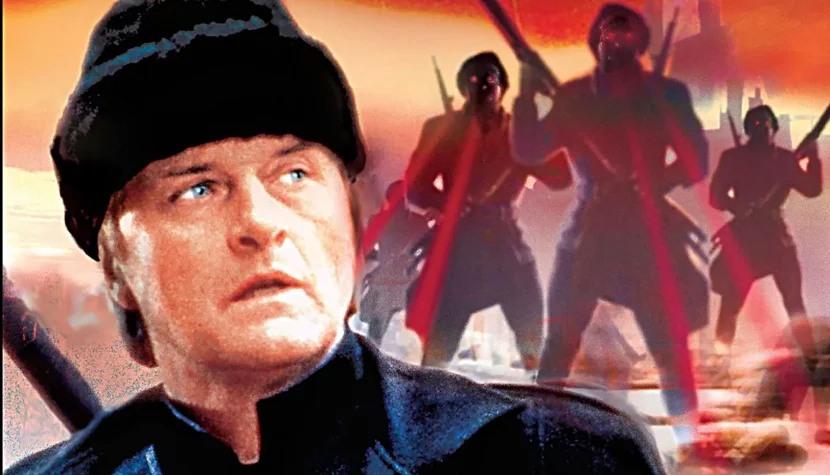OMEGA DOOM. Science fiction about the apocalypse according to cyborgs

You really have to love cinema to make such films and not give up. Albert Pyun loved it. He consistently pursued his vision of a post-apocalyptic science fiction world, completely disregarding opinions, and the ones about “Omega Doom” were never good. Compared to “Knights” or “Nemesis”, this film never gained cult status in ’90s sci-fi, let alone on VHS. Not even Rutger Hauer helped, whose legendary status was long behind him, and by the late ’90s, he had firmly established himself in B-movies. Yet in “Omega Doom”, he gave quite a lot, considering the quality of the story Albert Pyun came up with for him. Therefore, even though I consider this production one of the weaker ones in the director’s peculiar career, I think that compared to many contemporary SF films costing millions of dollars, it surprisingly has a lot of substance. It doesn’t matter that it’s illogically pieced together internally; that’s a minor detail. What counts is the atmosphere and how the androids are presented, along with their future, surprisingly similar to humanity’s.
The plot of “Omega Doom” is based on a concept as worn out as a colorful magazine at a hairdresser’s: humans created the desired robots, and they rebelled, triggering a total war. The world turned red. Mushroom clouds appeared on the horizon, almost like those that sprout after rain, and each of them brought death to everything around them, including androids, robots, and cyborgs. However, it didn’t happen all at once. First, a conventional war broke out. It’s hard to say who first decided to use nuclear weapons. It happened at the end of the entire conflict. It could have been the humans, realizing that if the bombs exploded, it would be much harder for cyborgs to find energy, and the human species, like any protein-based life, would find a way to survive. They were right. When the post-nuclear era of darkness began due to the destruction of all power plants, the cyborgs also found themselves in an almost hopeless situation. Most of them were hostile to humans, but there was one among them who, due to an accident—shown at the very beginning of the film—forgot what he was created for. And he was meant to exterminate humans. “Omega Doom” (Rutger Hauer) became a pro-human android. He made his way through the battlefield and reached a peculiar town where he encountered a degenerate community of robots. Yes, the war affected them as well. As true offspring of humans, they shared the fate of their creators, regardless of their level of advancement. Above all, they were unable to create a society, only to plunge into a timeless existence.

They only thought they had cleansed the world of humans. Biological life hadn’t disappeared from Earth. And here, director Albert Pyun turned out to be quite innovative. He made a film basically about cyborgs alone, giving them very distinct personalities, and he could have gone further, giving them a counterbalance in the form of a developed subplot about the remnants of humanity. However, he focused on the main character, who—though artificial—imitates the best Western standards as an outlaw gunslinger at odds with the world. Could it be that Albert Pyun was inspired by Clint Eastwood and his character of the Stranger from “High Plains Drifter”? Or maybe it was another nameless gunslinger, plastically constructed by Sergio Leone in “For a Few Dollars More”? When “Omega Doom” arrived in the ruined town, where he encountered an unusual community for B-class science fiction—robots and ROMs (newer and more advanced devices)—he realized that a similar racial, ideological, and “national” conflict was already brewing among the cyborgs, just as it had once done among humans. He also discovered that two very peaceful robots were trying to function in this society—one was a former nanny, now working as a bartender, whatever that means in a cyborg society, unless humans are also being served, and another was a rather learned, talkative robot, used by the other robots as a plaything. “Omega Doom” must deal with this society, which, like him, is searching for a weapons cache. Their goals, however, differ. Doom wants to use it to protect humans, while the cyborgs aim to destroy them for good.

The plot seems fairly original, but unfortunately, the film only lasts 80 minutes, so the director didn’t have time to develop some of the characters’ motives. The action takes place very locally, in a ruined area, without changing scenery, almost like a theater. The special effects are minimal, except for some minor electrical and energy discharges, and the tragically digitally cropped head of the android who is constantly humiliated by others. The fights between the cyborgs happen a few times and resemble gunslinger duels. Only the final fight sequence of “Omega Doom” features more choreography, but it’s filmed in such a way that it’s hard to make out many details of how the characters charge at each other and defend themselves. The most interesting part, however, is the finale when Doom sets off on a journey, but I hope you’ll discover that metaphor for yourselves.

